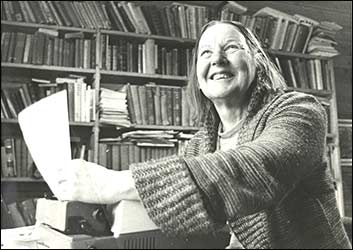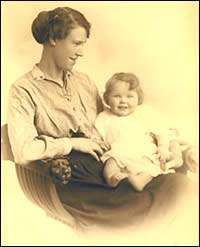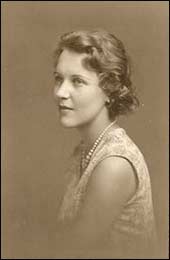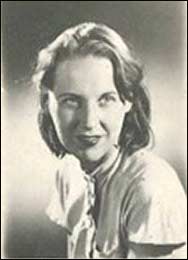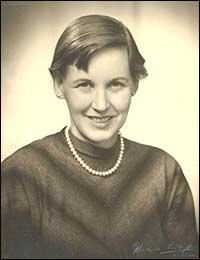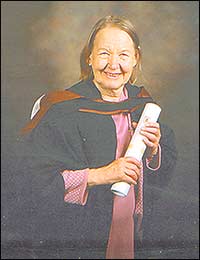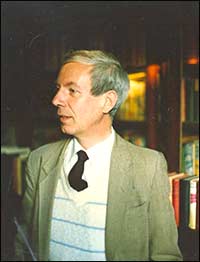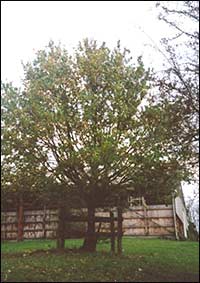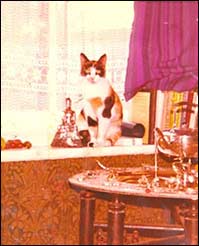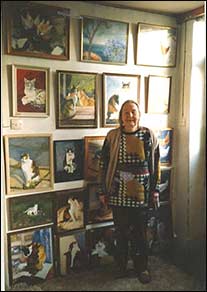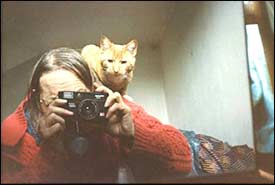A Wymington Neighbour Remembers
“The house next to ours was unoccupied, but one day I noticed activity there. I wondered who the newcomers would be. Did they like cats? I had ten at the time, mostly strays. I need not have worried.
Next morning there was a very loud thump on the door, and there stood a little lady smiling, saying she had come to make herself known, and to get to know me. I asked her in and with a cry of “How delightful”, she scooped two cats from a chair and sat with them on her lap.
“I’m so glad you love cats,” she said. “I was afraid you would not like mine.”
She explained that her flat in London was not suitable for them, so had asked Martin Booth, an old friend and fellow author to find her a house. He was teaching at the Boy’s School in Rushden then, and found her a suitable house.
We soon realised we had many things in common beside the cats. We were close in age and were both deaf. We read the same authors, and both looked on much housework as a waste of good reading time. Here we differed a little. I liked cooking, especially baking – (I must have made her well over twenty birthday cakes). Jean did not like cooking, and did very little. She ruined many a saucepan by putting on the vegetables on for a meal, then picking up a book, becoming engrossed in it – and another blackened mess was dumped in the bin.
We picked politicians to pieces, convinced we could do a better job. We both loved the natural world. I remember her excitement every Spring when she found the first snowdrop or violet in bloom, and fetching me to see it.
She soon learned the names of the wild flowers, and from her rambles in the fields would bring flowers and leaves for me to identify. She once asked how I knew birds by their song, and I said they were all different, each species has a distinctive sound, like our own voices.
I kept a few hens, and Jean wanted to do the same. She bought six from an advertisement in the local paper, thinking they could just live in her garden. Next morning they had all disappeared, but a frantic search of the village recovered five. We told her they must all be shut up securely at night and in a run during the day.
A neighbour had collected a huge pile of wood for a November 5th Bonfire, and it included some old doors and other useful bits of wood. He helped my husband erect a little shed out of these at the end of the garden, and they wired off a long run.
Jean was never happier than when digging and planting her garden, but much of her effort came to nothing, as she still let the hens out. At night, if they would not go in, I was called to help, and she painted a big picture of me, arms outspread, stick in hand, chasing them in.
When the hens began to venture into the house – with predictable results - Jean began to think about a home help, and found Mrs. Goodman, who remained a good friend and helper.
The hens gradually died off, and Jean was without for a time, but one day a small grey speckled hen flew in over the gate, and stayed. She was named Millicent and spent her time in the garden and the house, laying her daily egg in an armchair, and sleeping there at night.
|
|
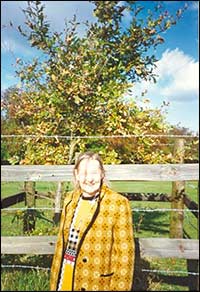 |
|
With the paintings
|
and with the oak tree
|
|
Jean wrote many poems about her cats, hens and other creatures, having them all published as little booklets, illustrated by her charming drawings. She gave some of these to friends instead of cards at Christmas.
Then she had an urge to drive, and began lessons. Her first instructor gave her up in despair, but the next one had more patience. After four years and 277 lessons she finally passed. She bought a car and was making plans to take me to St. Albans to see something of interest, when a minor accident made her give up driving, so we never went, to my great relief. She was a terrible driver. A ride into Rushden could be a hair-raising experience.
Then she took up riding, and had lessons with Shirley Warner. She loved the horse she rode, and wanted to keep Rose, but was not able to.
Jean practised yoga until in her nineties and it was no surprise to walk in and find her doing headstands with feet waving in the air. I resisted her attempts to get me to do the same, she said it would be beneficial to me, but I could not believe that.
She joined none of Wymington Village’s organisations, but always supported their fundraising events, and gradually got to know a few more people.
|
|
|
Jean the photographer with cat
|
|
When our daughter Margaret – a teacher in London – was home in the holidays or at weekends, she was often invited down for a cup of tea and a chat. She mowed the lawns, pruned trees and made herself generally useful.
Jean did not have a clue about anything electrical or mechanical, any more than I did, so when things went wrong, she would call on one of our sons for help. They always put things right, which, I suppose is why she thought they were both electricians, although John was an architect and Charles the Manager of a department in Peter Crisp's.
Another memory I have concerns a stray cat who lived with us both. One cold morning I saw a beautiful ginger cat down the garden. He was licking the empty dishes the hedgehogs fed from, so I opened a can of food and called him. He came racing down, bolted the food, rubbed round my legs, came in and sat by the fire.
Enquiries failed to find his owner, so I named him Tomas, and kept him some months. Then he disappeared, but days later I saw him in Jean’s garden, wearing a collar and was being walked round on a long lead.
I went down and she beamed - “I’ve got a stray” she said. “I shall call him Alexander, he is just like your Tomas.” Jean’s eyesight was very bad by then, as she often used a big magnifying glass to read. She was disappointed when I told her it was indeed Tomas, so I said I didn’t mind her keeping him if he wanted to stay with her, which he did, for years, never coming back to me.
Until one cold morning, like when he first came, I heard strange noises. Alexander was on the doorstep wailing and making an awful row. Just then Jean came to ask if I had seen him, so took him home. He protested loudly. The next day exactly the same thing happened, he looked very weak, and was taken back again.
The third day Jean watched him. He crossed the garden and the hen-run, and struggled through a very small gap between the hen-run and our garage, into our garden and down to the back door, still making these awful noises. Jean fetched him, and he died a few hours later. What made him come back to me? Did he remember once living here? Did he want to die here? We could not understand it. There was no rational explanation.
Jean was a prolific writer, not novels but serious books – poetry and biographies. She moved in a cosmopolitan set, artists, politicians and authors. An old friend was Dylan Thomas. “Poor Dylan” she said, “Ruined by alcohol. He should have married Pamela Hansford Johnson.” Pamela was another famous writer in their set.
She not only wrote and painted, but was an actress for a time with a Repertory Company, travelling all over the country with them and playing different roles. An old poster she kept showed how beautiful she was then.
She told me many anecdotes about her Wartime friends. One special one was Noor-un-Nisa Khan, an American – Indian girl. Under the code name Madeleine, she was flown into occupied France to work as a wireless operator with the French Resistance. Noor spent her last hours with Jean before her Special Operations Executive training, talking far into the night in what was to be their last conversation.
After an unusually long time in the field and in much danger, Noor was due to be brought out, but was betrayed to the Germans that day. Noor was arrested and taken to Dachau, tortured and shot, steadfastly refusing to give any information.
This prompted Jean to be the first biographer of Noor Inayat Khan. She actually tracked down the Officer who initially interrogated Noor in Paris, interviewing him there in 1950, to try and discover more about Noor’s fate.
For a time during the War, Jean worked in the Postal Censor’s Office. When I said that must have been interesting, she replied, “No, there is nothing so boring as other people’s letters.” But judging by the books she wrote, I realised she knew a great deal more of what was going on than from other people’s letters.
She wrote about the Special Operations Executive, headed by Col. Buckmaster, who was responsible for sending Noor to France. Jean was talking about him to me once when she stopped, then said quietly, “Buckmaster was an ass,” but she never said why. She wrote a lengthy book about Dericourt, a double, some thought a triple agent, but Jean thought he was really on our side. Her book about him and “The German Penetration of the S.O.E.” made very interesting reading.
Late one evening in January 2009, Jean had a fall while walking up to the post box. Luckily a neighbour, Mr Brian Capell saw her, helped her up, got her home, fetched me and called an ambulance. Jean said she was all right and did not want to go to hospital. “I’m going to bed,” she said, and went.
I followed a few minutes later, she was fast asleep already. The ambulance arrived and I called down, “She is asleep.” “You will have to wake her” said the ambulance man, so I gently shook her shoulder and called her name. She sat up, saw the men and said “What’s this for?” I said she must go just for a check-up to make sure she was well, so she went, still grumbling.
She was kept in for a time, but came home again and celebrated her 94th birthday with a party for friends, which she enjoyed. She was in very good spirits, but sadly soon had to go back to hospital, where she died.
I was not very mobile by then, but was able to go to her funeral, and I was so glad I did. On a bright sunny April day six of us went from Wymington to Golders Green Crematorium, where we met my daughter Margaret and seven other people. A small congregation to say goodbye.
High in the chapel wall was a big round stained glass window, and during the short service the sun shone directly through onto Jean’s coffin, bathing it in a kaleidoscope of beautiful colours. From the surrounding candles, wisps of smoke curled up through the radiant light. It was so lovely. I thought what a fitting end it was for her, she so loved colour and light. I wish she could have seen it. Perhaps she did?”
Mrs. Stella Reynolds
July 2010
|
